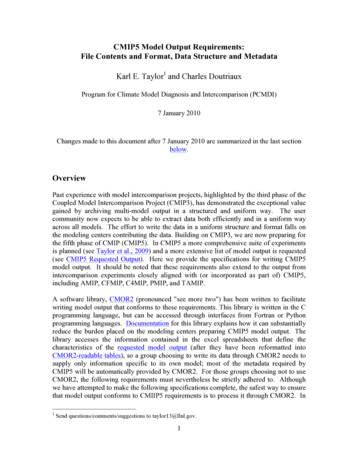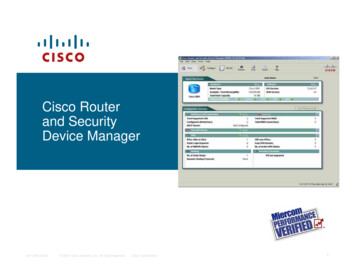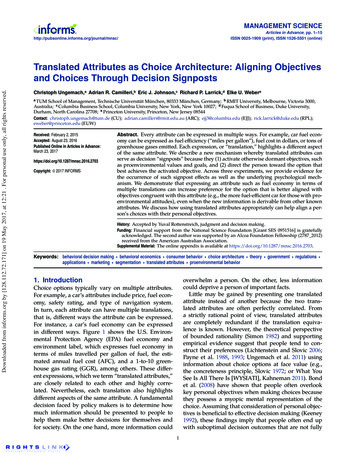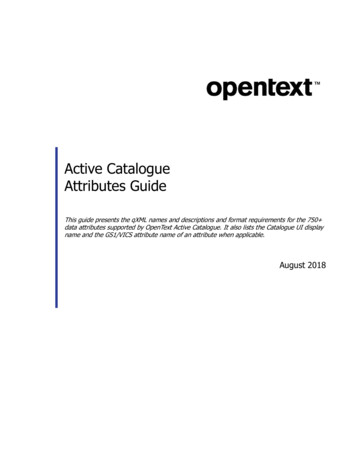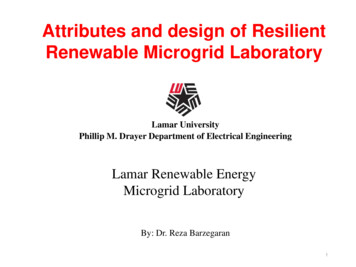
Transcription
Attributes and design of ResilientRenewable Microgrid LaboratoryLamar UniversityPhillip M. Drayer Department of Electrical EngineeringLamar Renewable EnergyMicrogrid LaboratoryBy: Dr. Reza Barzegaran1
Incentives to build resilient and reliable grid in south-east Texas Hurricane Rita and Hurricane Ike were the largest and most damaginghurricanes to hit Beaumont, TX, causing 11.3 billion and 31.5 billion,respectively, in total damage to the U.S. The state of New York and New Jersey had the same experience withhurricane sandy and after the hurricane they have implemented CHPincentive programs focused on improving state energy resiliency. The state of Texas and specially the south Texas has the highest capacity ofCHP in U.S The presence of the huge resources and refineries in this area “goldentriangle” which produces and consumes hydrogen for their production is themain resource of renewable cogeneration In the United States, the annual cost of outages in 2002 is estimated to be inthe order of 79B, which equals about a third of the total electricity retailrevenue of 249B. Much higher estimates have been reported by others.2
Community microgridCommunity microgrids aim primarily at supplying electricity to a group ofconsumers in a neighborhood or several connected neighborhoods inclose proximitymust have three distinct characteristics:1) the electrical boundaries must be clearly defined,2) there must be control systems in place to dispatch Distributed EnergyResources in a coordinated fashion and maintain voltage and frequencywithin acceptable limits3) the aggregated installed capacity of DERs and controllable loads must beadequate to reliably supply the critical demand.3
So what’s the problem and how to fix itSeveral obstacles exist in the rapid and widespread deployment of communitymicrogrids, including: The high capital cost of microgrid deploymentefficient planning models are required to: ensure the economic viability of microgrid deployments justify investments based on cost-benefit analyses under uncertain conditions The lack of consumer knowledge on potential impacts of DG and loadscheduling strategiesthe most powerful driver for performing load scheduling: The financial incentives offered to consumers, who would consider load schedulingstrategies. Furthermore, the emergence of smart metering as well as state-of-the-art devices andbuilding management systems have helped reduce this barrier Particularly ownership and regulatory issues microgrid ownership, third-party generation participation, investment recovery, andinclusion in the utility rate case are the issues that must be resolved4
Wide Area Control ofPower GridPower StorageWAMSCommunicationCommunicationSolar FarmPSSActuationResponsive LoadWind FarmGenerator1-5FACTS
Benefits of community microgrids Security: mitigate the impacts of physical and cyber threats through islanding Reliability: intrinsic intelligence (control and automation systems) of communitymicrogrids and the utilization of DERs Resiliency: local supply of loads even when the supply of power from the utility grid isnot available Emission reduction: using the coordinated control of a combination of dispatchableDGs, DES, and controllable loads to “smooth down” the intermittent output of renewableenergy resources Reduced cost of recurring system upgrades: reducing T&D congestion issues bydeploying distributed energy resources and storage Energy efficiency: by reducing T&D losses and allowing the implementation of optimalload control and resource dispatch. Power quality: by enabling local control of the frequency, voltage, and load, and a rapid response from the DESLowered energy cost: reducing T&D cost and also load scheduling strategies6
Basis for developing a state of the art test bedScientifictheoriesComputationaltoolsNew technologyTest bedExperimentationAs DevelopmentenvironmentReplicableProof ofconceptTransparentSafe and shielded fromhazards of testingExpandableRigorous7
Attributes Our main objective here is to use composable modules for developing a resilienttest bed microgrid in a laboratory environment. In general a well developed test bed laboratory will provide the following abilities:– Achieve full potential for testing practical issues in smart grid research– Investigate and validate the performance in an isolated platform– Characterize the components, equipment's and systems in flexiblearchitectures– Develop, integrate and verify new ideas and techniques– Capabilities to practically use, test and enhance modern standards– Provide an environment and interface for related fields such as market analysis– Enable remote operation (i.e. online or off campus accessibility)8
Attributes– Abilities of the Test Bed from a technical point of view:– Develop communication infrastructure– Develop real time monitoring of the hybrid system– Implement a variety of architectures and connectivity to emulate differentsystems and microgrids.– Involve trainees in the development and building the various test bedcomponents– Develop and evaluate hardware/software solutions by hand and experimentwith it.9
Attributes– Abilities of the Test Bed from a technical point of view:– Develop and implement wide area Protection System.– Study important issues such as real-time voltage stability– Develop monitoring and operation strategies using Synchorophasors– Conduct experiments on EMS for smart grids including alternate andsustainable sources– Integrating embedded architecture and distributed control through intelligentagents– Improving the market analysis and economic studies10
Consequently:Test bed needs to have the following components in an integrated platform and will provide usseveral capabilities. The main Requirements are listed here: Phasor measurements units monitoring, protection, and controlIntegration of distributed and renewable energy sources wind, solar, Fuel cell, etc.The development of new schemes protective digital relaying Wide Area ProtectionIntelligent protection schemes and their application for Prevent cascading outages Islanding situations Grid blackoutEmulation of Plug-In-Hybrid Electric Vehicles (PHEVs) and Electric Battery Vehicles(EBVs) Energy Storage systems, SOC and SOH for batteriesIntegration of Hybrid AC-DC systems micro grid solutions for residential and industrial applications. Enhancement of Energy Efficiency and EMSIntegration of Multi Agent in an embedded platform Smart meters, HIL11
Schematic of composable modules integrated in the test bed12
Composing a smart grid test bed at a laboratory scale AC Grid Components Bus Synchronizer Generation stations Dynamic brake Transmission line Communication platform Software Platform SCADA Protection module Online monitoring Generation control Data base and archiving Power System analysis Loads13
Composing a smart grid test bed at a laboratory scale DC Microgrids Components Modular MIBBCBattery BankProgrammable Load emulatorDC bus moduleHigh Freq. Invertermore Hybrid PEVs Charging systemComponents RL FilterBidirectional ac/dc converterBidirectional dc/dc converterHardware OverviewLithium-ion BatteryManagement,Diagnostics Software AC/DC interconnected networkcomponents–Uncontrolled rectifier–Dynamic load emulation–AC Filter–DC Filter–DC/Dc Boost Converter–AC/DC Measurements and Protection–DC Power Module–Medium voltage DC Transmission line modelComponents of Microgrids for pulse loadstudies–––––Super capacitor bankBidirectional converterMulti port Boost ConverterLead Acid Battery BankProgrammable DC Load14
Composing a smart grid test bed at a laboratory scale Distributed control components Embedded agent platformHIL simulatorsDDS infrastructureSmart Meters Developed Interface library Phasor measurement Components PMUsPDCsRTACsInterface for control and protection modulesReal time phasor data server15
Utilization and Applications of composable modulesin smart grid test bed Steps from design to operation Voltage and current measurement Security analysis Embedded Control architecture PMUs and RTAC Hybrid PEV charging station Pulse load studies DC System monitoring and protection16
Utilization and Applications of composable modulesin smart grid test bed Wind, PV and Energy storage integration Implementation of DC architecture studies Modular interconnected WECS Control system AC/DC Interconnection Grid StudiesMulti Agent Environment and Social behavior analysis and pricing17
Steps From Design to complete operationOf a composable moduleExample:Serial RS232 to RS485 converter31245687Applications18
Voltage Measurement Calibration module3 phase Voltagemeasurement byPTsPTs and CalibrationpotentiometerTraditional Measurementusing precise metersMeasurements bytransducers and dataacquisitionPTs Measured valuesDevice undercalibrationVariable loadFor voltage measurements, we would liketo have precise measurements in a rangebetween 100-130V (for a 120V system).Real ValuesCoefficients for 3phasesNextDeveloped PT calibration moduleTrack of differentMeasurement rangesPrecise meterCompensation of Nonlinear PTmeasurements by different polynomial19
Current Measurement Calibration module3 phase Voltagemeasurement by PTsTraditional Measurementusing precise metersPTs and Calibration potentiometer(linear/scale compensation)Device undercalibrationCTs Measured valuesCurrent RangePrecise meterVariable loadReal ValuesCoefficients for 3phasesNextMeasurements bytransducers and dataacquisitionDeveloped CT calibration unction plotReal ValuesMeasuredvaluesCompensation of Nonlinear CT20measurements by different polynomialcorrection
Post design requirement checks:Measurement Calibration&Measurement linearizationInverse lsRealValuesMeasuredvaluesCoefficients of the inverse polynomial: q1 0.0680 0.0240 q2 -0.0001 0.0812 -0.0209 q3 -0.0000 0.0005 0.04990.0127Applications21
SubstructureSoftware n to ACGridComponents22OutputsBlockdiagramInputsReceive all dataCommunication tounitsControllersGlobal databaseCapture resultsData acquisitionGeneration/demandstatusCommunication settingsBlock diagramauthorize datarequestsApply changesDatPIDaacq controlluisiterionGeneration controlArchivingOperatorcapabilityFront al unit rsFrontpanelDigsilent interfaceDynamic brakeAnalysisPhase controlRead topology andvaluesFrequency controlBlockdiagramAutomaticOnline MonitoringManual set pointValidate dataFront PanelRequest dataAlarmsBlock DiagramBusesSCADALinesPower calculationStationsProtectionmoduleRMS, phasePhase reference t panelEvent loggerOperatorcapabilitiesData acquisitionInstrumentsProtection relayfunctionsOutput commandsAccess to detailsTopology changeAlert indicationsEnvironmentLoad changeStructureWhole mimic viewLabviewProjectTest bed software alculationNeeds andfunctions
DC System Monitoring for Protection PurposeA schematic diagram of the hybrid dc microgrid for Protection studyNext23
Practical Implementation of wind, PV, energy storagesin Microgrids with Modular ComponentsHigh Freq.InverterDC BUSGenerator-RectifierSubsystem DC-BusAC GridAC-BusBatteryBankAlternate Resources &Energy StorageGInverter-GridSubsystemUtilityGridGenerator adsDC-LoadBatteryMIBBCProgrammableLoadMulti phase ACBusApplications24
MeasurementsControl SignalsApplications
InverterRectifier𝑳RL ��G1𝑔𝑗𝑢𝑎𝑗R 𝐿𝑔 Grid𝑔𝑢𝑏𝑗𝑔𝑢𝑐Line voltages & currentsmeasurements𝑳SVPWM𝑣𝛼𝑟 𝑣𝛽𝑟𝑪G2 𝛼𝛽PI𝑣𝑑𝑟𝑟𝑑𝑞 𝑣𝑞 SVPWMLine voltage &Current ���𝛼 𝑔𝑢𝑞𝑣𝑟𝛽VOCSPLL 𝑑𝑞𝑔𝑢𝑑 𝜔𝐿𝑖𝑑𝜔𝐿𝑖𝑞PI ference currents calculation𝑖𝑞𝑟𝑃𝑟𝑄𝑟Active & Reactive powerdemanded calculation𝑉𝑑𝑐26
Logical structure of distributed Multi-agent Environment andrelation to Social Behavior Analysis and PricingPrice signalAgent configuration andparameter initializationApplicationsState of charge Load DemandGenerationavailabilityLoad Demand27
Real-time nondestructive Harmonic and inter-harmonicreduction of electric machine drivesToPWMSpectrum ComputationLNAADCLPFLPFLow Noise Analog to Low PassFilterAmplfierDigitalConverterLow PassFilterSensor and conditioner �3.α6DesiredFrequencyMain ControlDDSDirect DigitalSynthesizerThe structure of the controller is composed of 3 blocks; 1) Sensor andConditioner, 2) Spectrum Computation and 3) Main Control28
Conclusion Having modular components in an microgrid test bed is anecessary requirement. It will help to extend the system,replace the defective component, and enhance theinterconnectivity of components. Modules require extended specifications with lowestlimitations for their application. It will provide environment for developing, integrating,testing and evaluating ideas, components, and recentadvancements It need standards, to be used, tested or even improved Finally it should be designed in a way to achieve fullpotential of smart grid29
Lamar University Phillip M. Drayer Department of Electrical Engineering 1. Incentives to build resilient and reliable grid in south-east Texas Hurricane Rita and Hurricane Ike were the largest and most damaging hurricanes to hit Beaumont, TX, causing 11.3 billion and 31.5 billion,
